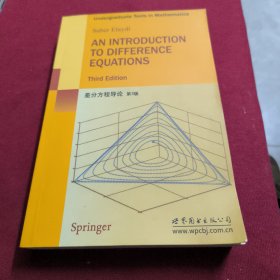
差分方程导论
¥ 80 九品
仅1件
北京朝阳
认证卖家担保交易快速发货售后保障
作者埃莱迪(Saber Elaydi) 著
出版社世界图书出版公司
出版时间2011-04
版次1
装帧平装
货号H2
上书时间2024-07-18
- 在售商品 暂无
- 平均发货时间 10小时
- 好评率 暂无
- 最新上架
商品详情
- 品相描述:九品
图书标准信息
- 作者 埃莱迪(Saber Elaydi) 著
- 出版社 世界图书出版公司
- 出版时间 2011-04
- 版次 1
- ISBN 9787510033070
- 定价 59.00元
- 装帧 平装
- 开本 24开
- 纸张 胶版纸
- 页数 539页
- 【内容简介】
-
《差分方程导论(第3版)》是一本学习差分方程的本科生教程。书中将差分方程的经典方法和现代方法有机结合,包括了最新最权威的一手材料,并且在表述上足够简洁明了,适合高年级的本科生和研究生使用。《差分方程导论(第3版)》是第三版,这版中包括了更多的证明,图表和应用,增加了许多新的内容,如,讲述高阶尺度差分方程的一章;有关一维映射的局部稳定性和全局稳定性的内容;介绍解的渐进思想的一节;levin-may定理的详细证明以及lap flour-beetle模型的最新结果。
读者对象:数学专业的本科生,研究生和相关的科研人员。 - 【目录】
-
preface to the third edition
preface to the second edition
preface to the first edition
list of symbols
1 dynamics of first-order difference equations
1.1 introduction
1.2 linear first-order difference equations
1.2.1 important special cases
1.3 equilibrium points
1.3.1 the stair step (cobweb) diagrams
1.3.2 the cobweb theorem of economics
1.4 numerical solutions of differential equations
1.4.1 euler‘s method
1.4.2 a nonstandard scheme
1.5 criterion for the asymptotic stability of equilibrium points
1.6 periodic points and cycles
1.7 the logistic equation and bifurcation
1.7.1 equilibrium points
1.7.2 2-cycles
1.7.3 22-cycles
1.7.4 the bifurcation diagram
1.8 basin of attraction and global stability (optional)
2 linear difference equations of higher order
2.1 difference calculus
2.1.1 the power shift
2.1.2 factorial polynomials
2.1.3 the antidifference operator
2.2 general theory of linear difference equations
2.3 linear homogeneous equations with constant coefficients
2.4 nonhomogeneous equations: methods of undetermind coefficeints
2.4.1 the method of variation of constants (parameters)
2.5 limiting behavior of solutions
2.6 nonlinear equations transformable to linear equations
2.7 applications
2.7.1 propagation of annual plants
2.7.2 gambler’s ruin
2.7.3 national income
2.7.4 the transmission of information
3 systems of linear difference equations
3.1 autonomous (time-invariant) systems
3.1.1 the discrete analogue of the putzer algorithm.
3.1.2 the development of the algorithm for an
3.2 the basic theory
3.3 the jordan form: autonomous (time-invariant) systems revisited
3.3.1 diagonalizable matrices
3.3.2 the jordan form
3.3.3 block-diagonal matrices
3.4 linear periodic systems
3.5 applications
3.5.1 markov chains
3.5.2 regular markov chains
3.5.3 absorbing markov chains
3.5.4 a trade model
3.5.5 the heat equation
4 stability theory
4.1 a norm of a matrix
4.2 notions of stability
4.3 stability of linear systems
4.3.1 nonautonomous linear systems
4.3.2 autonomous linear systems
4.4 phase space analysis
4.5 liapunov‘s direct, or second, method
4.6 stability by linear approximation
4.7 applications
4.7.1 one species with two age classes
4.7.2 host-parasitoid systems
4.7.3 a business cycle model
4.7.4 the nicholson-bailey model
4.7.5 the flour beetle case study
5 higher-order scalar difference equations
5.1 linear scalar equations
5.2 sufficient conditions for stability
5.3 stability via linearization
5.4 global stability of nonlinear equations
5.5 applications
5.5.1 flour beetles
5.5.2 a mosquito model
6 the z-transform method and volterra difference equations
6.1 definitions and examples
6.1.1 properties of the z-transform
6.2 the inverse z-transform and solutions of difference equations
6.2.1 the power series method
6.2.2 the partial fractions method
6.2.3 the inversion integral method
6.3 volterra difference equations of convolution type: the scalar case
6.4 explicit criteria for stability of volterra equations
6.5 volterra systems
6.6 a variation of constants formula
6.7 the z-transform versus the laplace transform
7 oscillation theory
7.1 three-term difference equations
7.2 self-adjoint second-order equations
7.3 nonlinear difference equations
8 asymptotic behavior of difference equations
8.1 tools of approximation
8.2 poincare’s theorem
8.2.1 infinite products and perron‘s example
8.3 asymptotically diagonal systems
8.4. high-order difference equations
8.5 second-order difference equations
8.5.1 a generalization of the poincare-perron theorem.
8.6 birkhoff’s theorem
8.7 nonlinear difference equations
8.8 extensions of the poincare and perron theorems
8.8.1 an extension of perron‘s second theorem
8.8.2 poincare’s theorem revisited
9 applications to continued fractions and orthogonal polynomials
9.1 continued fractions: fundamental recurrence formula
9.2 convergence of continued fractions
9.3 continued fractions and infinite series
9.4 classical orthogonal polynomials
9.5 the fundamental recurrence formula for orthogonal polynomials
9.6 minimal solutions, continued fractions, and orthogonal polynomials
10 control theory
10.1 introduction
10.1.1 discrete equivalents for continuous systems
10.2 controllability
10.2.1 controllability canonical forms
10.30bservability
10.3.10bservability canonical forms
10.4 stabilization by state feedback (design via pole placement)
10.4.1 stabilization of nonlinear systems by feedback
10.5 observers
10.5.1 eigenvalue separation theorem
a stability of nonhyperboli fixed points of maps on the real line
a.1 local stability of nonoscillatory nonhyperbolic maps
a.2 local stability of oscillatory nonhyperbolic maps
a.2.1 results with g(x)
b the vandermonde matrix
c stability of nondifferentiable maps
d stable manifold and the hartman-grobman-cushing theorems
d.1 the stable manifold theorem
d.2 the hartman-grobman-cushing theorem
e the levin-may theorem
f classical orthogonal polynomials
g identities and formulas
answers and hints to selected problems
maple programs
references
index
点击展开
点击收起
相关推荐
— 没有更多了 —























以下为对购买帮助不大的评价